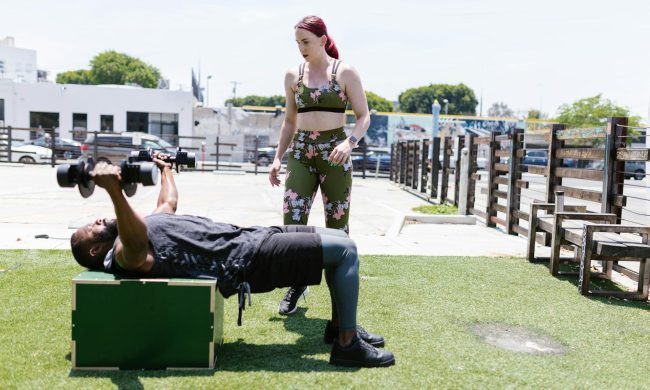If you want to lose weight, you’re not alone. Many people have a similar goal and are aware that exercise is a great way to make it happen. You might be wondering where to start and if you should choose cardio or weightlifting for weight loss or both.
While cardio exercises such as running, cycling, rowing, swimming, and stair climbing can all be excellent ways to burn calories, it’s also possible to lose weight by lifting weights. Strength training can strengthen your bones and muscles, reduce your risk of injuries, and improve your overall functional fitness. If you tend to gravitate toward strength training more than cardio workouts but still want to lose weight, keep reading for your complete guide to weight training for weight loss.
Can you lose weight by lifting weights?

One of the top weight loss tips that any health and fitness expert recommends is incorporating exercise into your weight loss program. Most people assume that this means cardio exercise rather than strength training. After all, the goal of strength training is often to build muscle mass; if you’re increasing your muscle mass, your body weight will increase.
However, this assumption does not take into account that as long as you follow a healthy, calorie-controlled diet and do the right type of strength training workouts, you can burn calories, build muscle, and lose weight at the same time. Moves like squats work multiple muscle groups to help you unlock your full potential.
As you build more muscle with strength training, your body burns more fat and calories, but it might take longer than if you were also to incorporate cardio in your training schedule. You can increase the weight and intensity over time, which is called progressive overload. It’s best to always check with your medical provider before trying resistance training for weight loss to make sure it’s suitable for you.
How lifting weights can help you lose weight

Resistance training is a really effective form of exercise for fat loss and body recomposition. The more you challenge yourself to engage certain muscle groups, the more you’ll develop strength and change your weight and body shape. Here are the ways resistance training workouts can fuel weight loss.
Lifting weights burns calories

Strength training burns calories like any form of exercise because your muscles need energy to contract, which requires burning stored fuel (glycogen and adipose tissue) to generate cellular energy or ATP. The number of calories you burn in a strength training workout depends on numerous factors, such as your body weight and composition, the intensity of the workout, the specific exercises you perform, and the duration or training volume of the workout.
You will burn more calories if you have a larger body size and a higher percentage of lean body mass relative to fat mass. You’ll also burn more calories if you lift heavier loads relative to your one-repetition maximum and take less rest. Your one-rep max or 1RM is the most you could possibly lift for one full rep while maintaining proper form. Lifting heavier loads and taking less time to rest increases the intensity of your workout and elevates your heart rate, which increases your energy expenditure and contributes to weight loss.
The longer your resistance training workout lasts at a high intensity, the more calories you’ll burn. Harvard Health Publishing reports that 30 minutes of “vigorous weightlifting” burns 180 calories for a 125-pound person, 216 calories for a 155-pound person, and 252 calories for a 185-pound person.
You can also use metabolic equivalents (METs) for strength training activities to estimate the number of calories burned. METs represent the energy expenditure of a given activity compared to that of sitting quietly, which is equal to 1.0 MET. The Compendium of Physical Activities reports that circuit training at a moderate effort is 4.3 METs, while resistance training doing squats is equal to 5.0 METs.
Circuit training with kettlebells and aerobic exercises with minimal rest is 8.0 METs. Using these METs values and the equation for energy expenditure, you can calculate the number of calories burned while strength training based on your body weight and the duration of your workout:
- Calories burned per minute = METs x 3.5 x (your body weight in kilograms) / 200
- For example, if you weigh 185 pounds (84 kg) and do resistance training with squats
- 5 METS x 3.5 x 84 / 200 = 7.35 calories per minute.
- Then, if you do a 45-minute workout, you multiply the number of calories burned per minute by 45 minutes. So: 7.35 x 45 = 331 calories.
You can burn more calories if you weigh more and increase the intensity of your workouts. You need to burn approximately 3,500 calories to lose one pound of fat, so it would take about 10 strength training workouts (about two weeks, depending on workout frequency) for you to lose one pound of body fat if you make no additional changes to your diet.
Lifting weights builds muscle mass

Lifting weights can increase your lean body mass by stimulating myofibrillar protein synthesis (MPS), which enhances the size of your muscle fibers by reinforcing them with new proteins. You’ll challenge your fast-twitch muscle fibers and boost your muscle mass and metabolism. Because muscle tissue is metabolically active tissue, increasing your lean body mass can increase your basal metabolic rate, so you’ll burn more calories throughout the day, even at rest. This will make it easier to create the calorie deficit necessary to lose weight.
Lifting weights can support healthy lifestyle choices

If you’re putting in the effort to weight train for weight loss, you might be more inclined to make healthy dietary choices to support your workout. Although this isn’t a given, many people find that they’re more motivated to eat nutritious foods and eliminate excessive sugar, alcohol, and processed foods once they start trying to optimize their physique through strength training workouts.
EPOC

With high-intensity workouts, you’ll also continue burning calories during the repair process of EPOC or post-exercise oxygen consumption, where your body recovers, repairs, and returns to the pre-exercise state.
Tips for losing weight with weight training

The following tips can help when you begin lifting weights to lose weight:
- Be mindful of your diet, maintain a calorie deficit, and consume nutritionally dense foods rather than processed sugary foods.
- Wear a heart rate monitor so you can gauge the intensity of your workouts.
- Lift the heaviest weights you can handle with proper form for 8 to 12 reps.
- Perform compound, multi-joint exercises.
- Consider circuit training or performing strength training exercises back to back to keep your heart rate elevated.
- Increase the frequency and duration of your strength training workouts. Aim for 2 to 3 sets of 8 to 15 exercises per workout, performing 8 to 12 reps per set.
- Take rest days.
- Ask for help from a personal trainer or join group classes.
- Always start with lighter weights until you master your form.
- Remember to breathe properly while lifting.
- Combining strength training, cardio, high-intensity interval training, and rest days can fine-tune your metabolism and boost weight loss results.
- Warm up and stretch for at least five minutes before you start.
Can you lose belly fat by lifting weights?

In general, if you successfully lose weight by weight lifting, then stored fat in your belly can certainly be burned as well! Unfortunately, you can’t spot reduce fat, so simply doing ab exercises will not result in you having less fat on your stomach.
Genetics determine where you tend to store fat the most and where your body will burn fat first and last. Most people naturally store fat in their abdominal area, making losing belly fat a common goal. Stick to your regimen, be patient, and you’ll eventually start to lose belly fat.
FAQs

What type of weight training is best for weight loss?
Compound exercises work best for weight loss because you’re working multiple joints and muscle groups at once. This maximizes your full-body results. High-intensity interval training is excellent for weight loss because it’s high intensity and incorporates a variety of effective exercises. One study found that high-intensity interval training burned 25% to 30% more calories than other types of exercise.
What is the 4-2-1 combo method?
The 4-2-1 method is a way of splitting up your workouts throughout the week:
- 4 days of strength training
- 2 days of cardio
- 1 day of mobility or active rest
Fitness buffs say the 4-2-1 method amplifies your weight loss success by priming your muscles for each day and merging cardio with strength training.
Should you do cardio and strength training?
Cardio and strength training are a worthy match that’ll fuel your weight loss journey. You can incorporate cardio as part of your high-intensity interval training, go running, or try a 10 to 15-minute warm-up before strength training. One of the main goals of cardio is to elevate your heart rate, which ramps up calorie burning.
Cardio is excellent for heart health and typically burns more calories per session than weight training. That being said, over time, you’ll burn plenty of calories with weight training because it’s more effective than cardio for building lean muscle mass, which burns more calories at rest compared to other tissues.
Sample weightlifting routine for weight loss (for beginners)

If you’re a beginner, you need to start somewhere. Here’s a simple weight training routine to get you started:
Warm-up
- 5 minutes of light cardio, such as jogging or jumping jacks
- 5 minutes of dynamic stretches, such as arm circles and leg swings
Weightlifting workout
- Squats with weights: 3 sets of 6 to 12 repetitions
- Deadlifts: 3 sets of 6 to 12 repetitions
- Bench press: 3 sets of 6 to 12 repetitions (use a spotter if you need to)
- Overhead press: 3 sets of 6 to 12 repetitions
Cooldown
- 5 minutes of light cardio
- 5 minutes of static stretches, such as holding a hamstring stretch or quadriceps stretch
As you get stronger, you can gradually increase the weight you lift and the number of sets and repetitions you perform. If you stick with it, you’ll shed the pounds and see the rewards of your efforts.




